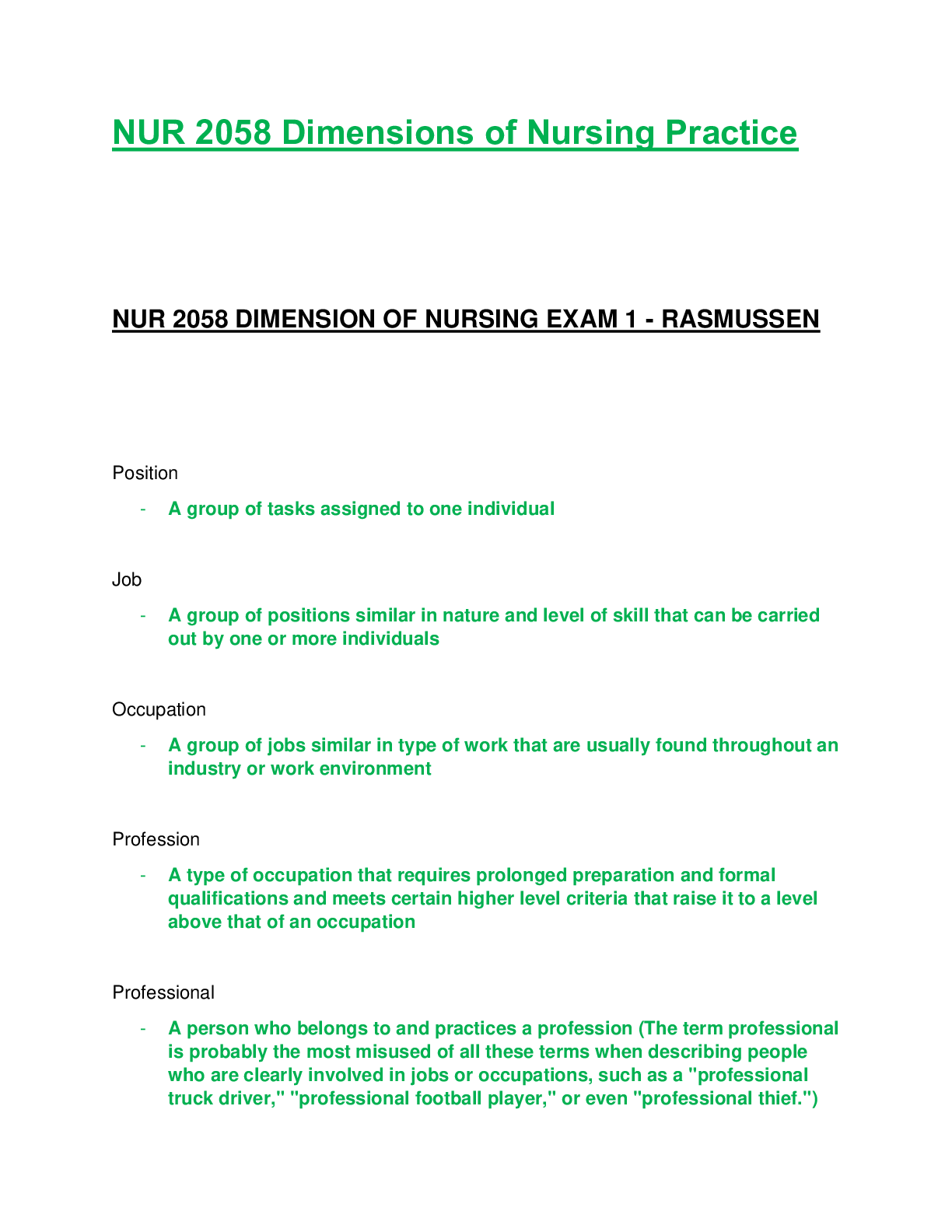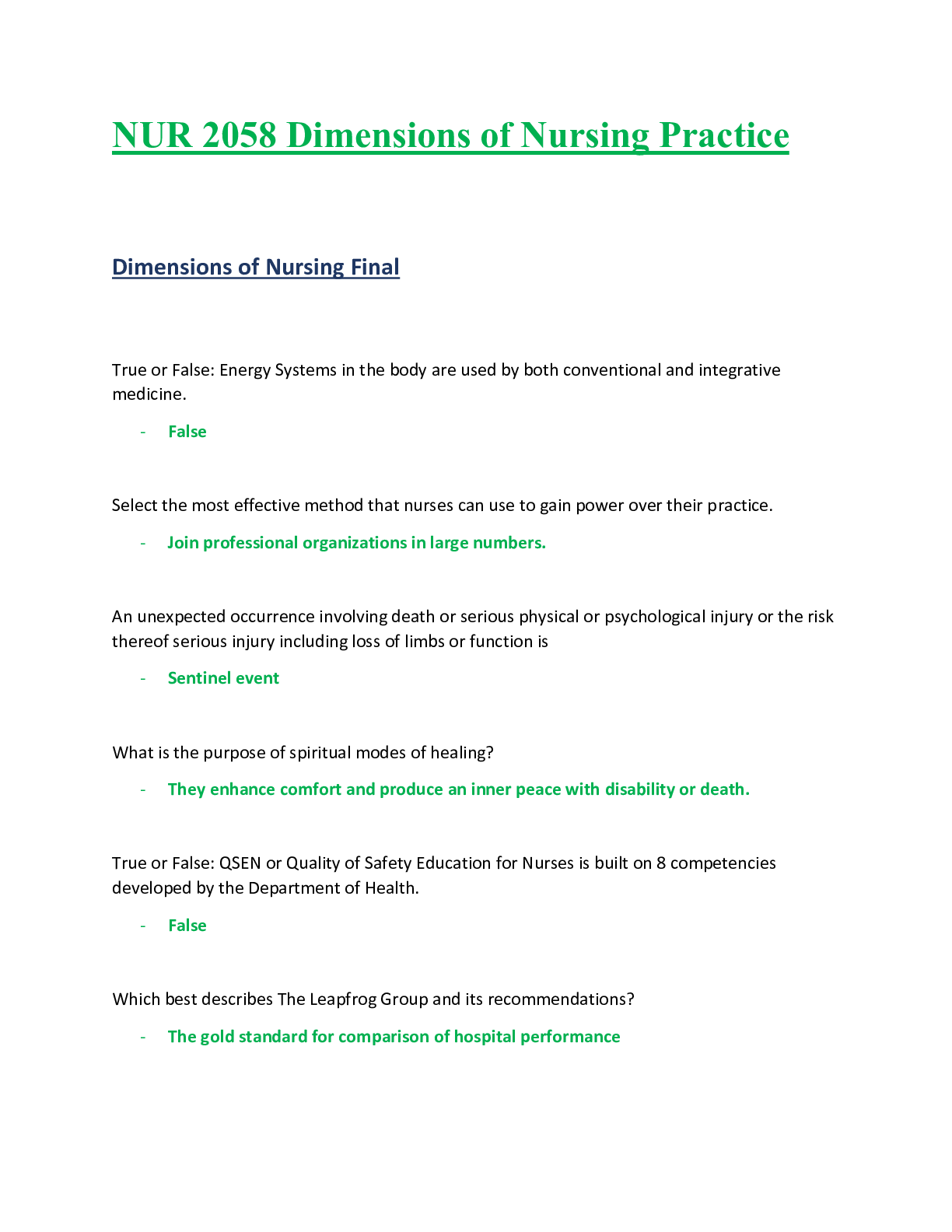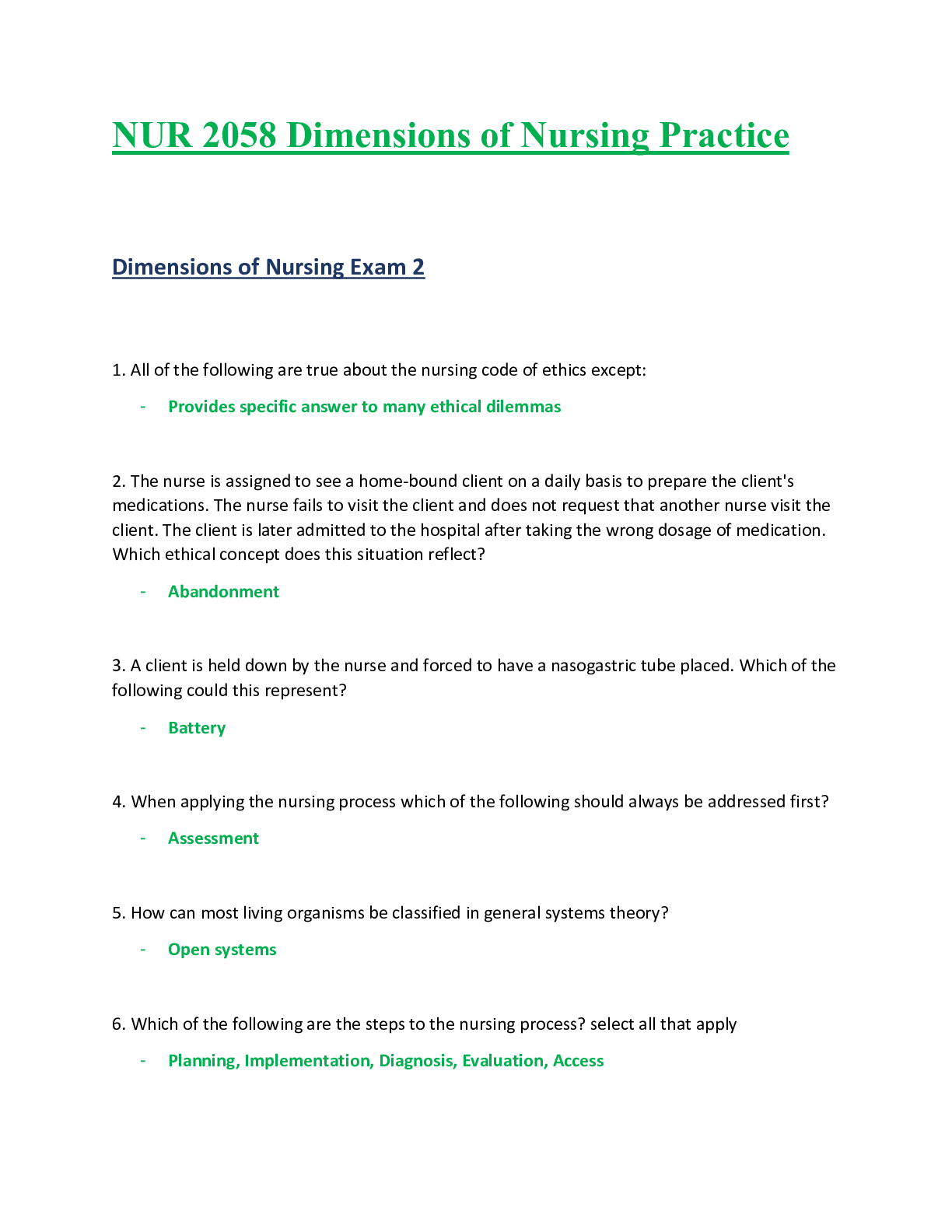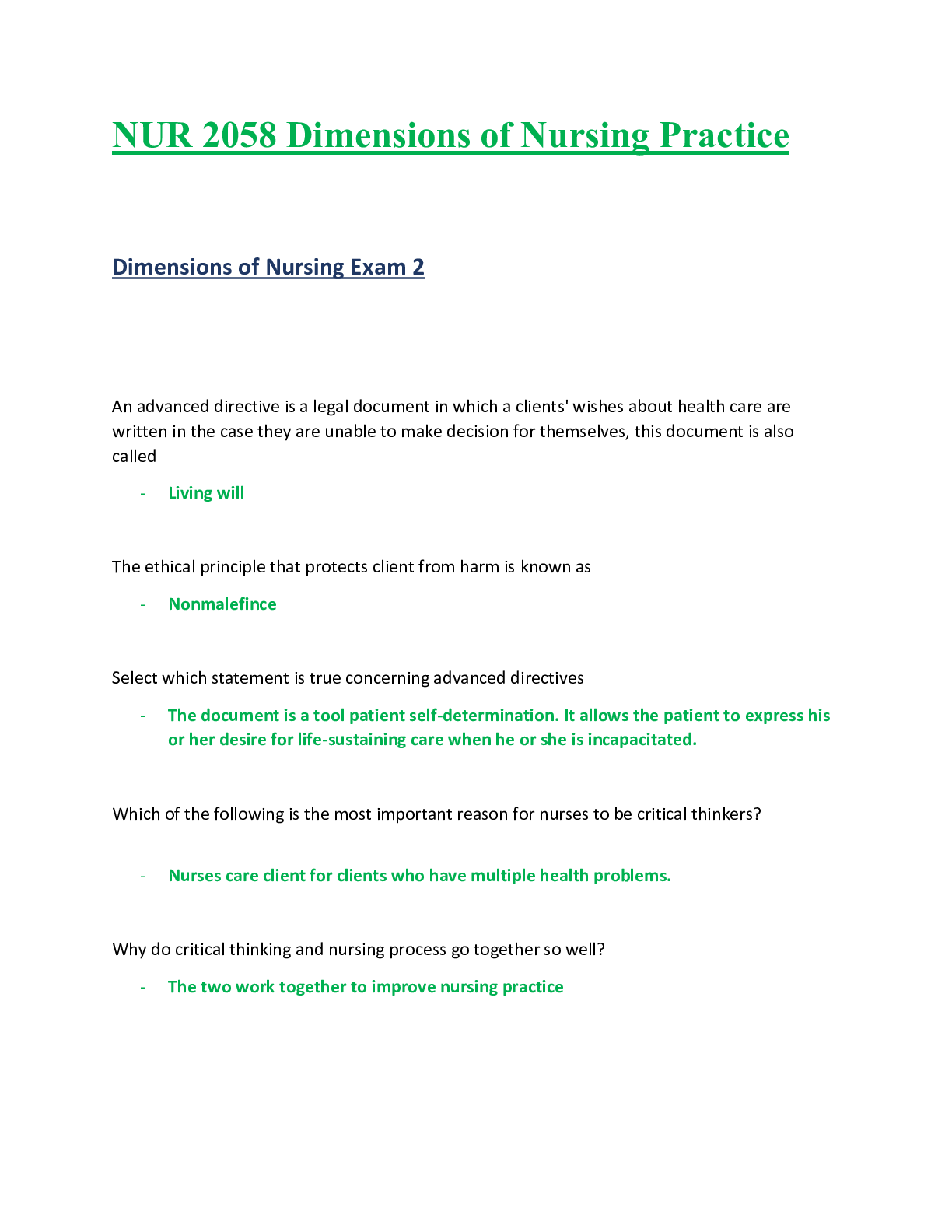Health Care > EXAM > Fundamental HESI, Hesi Fundamentals, Hesi Fundamentals Practice Test, UNIT 1: Foundations of Nursing (All)
Fundamental HESI, Hesi Fundamentals, Hesi Fundamentals Practice Test, UNIT 1: Foundations of Nursing Practice
Document Content and Description Below
Which assessment data would provide the most accurate determination of proper placement of a nasogastric tube? A) Aspirating gastric contents to assure a pH value of 4 or less. B) Hearing air pa... ss in the stomach after injecting air into the tubing. C) Examining a chest x-ray obtained after the tubing was inserted. D) Checking the remaining length of tubing to ensure that the correct length was inserted. - ANSWER C) Examining a chest x-ray obtained after the tubing was inserted Both (A and B) are methods used to determine proper placement of the NG tubing. However, the best indicator that the tubing is properly placed is (C). (D) is not an indicator of proper placement When assisting an 82-year-old client to ambulate, it is important for the nurse to realize that the center of gravity for an elderly person is the A) Arms. B) Upper torso. C) Head. D) Feet - ANSWER B) Upper torso The center of gravity for adults is the hips. However, as the person grows older, a stooped posture is common because of the changes from osteoporosis and normal bone degeneration, and the knees, hips, and elbows flex. This stooped posture results in the upper torso (B) becoming the center of gravity for older persons. Although (A) is a part, or an extension of the upper torso, this is not the best and most complete answer. Which action is most important for the nurse to implement when donning sterile gloves? A) Maintain thumb at a ninety degree angle. B) Hold hands with fingers down while gloving. C) Keep gloved hands above the elbows. D) Put the glove on the dominant hand first. - ANSWER C) Keep gloved hands above the elbows Gloved hands held below waist level are considered unsterile (C). (A and B) are not essential to maintaining asepsis. While it may be helpful to put the glove on the dominant hand first, it is not necessary to ensure asepsis (D). An adult male client with a history of hypertension tells the nurse that he is tired of taking antihypertensive medications and is going to try spiritual meditation instead. What should be the nurse's first response? A) It is important that you continue your medication while learning to meditate. B) Spiritual meditation requires a time commitment of 15 to 20 minutes daily. C) Obtain your healthcare provider's permission before starting meditation. D) Complementary therapy and western medicine can be effective for you. - ANSWER A) It is important that you continue your medication while learning to meditate The prolonged practice of meditation may lead to a reduced need for antihypertensive medications. However, the medications must be continued (A) while the physiologic response to meditation is monitored. (B) is not as important as continuing the medication. The healthcare provider should be informed, but permission is not required to meditate (C). Although it is true that this complimentary therapy might be effective (D), it is essential that the client continue with antihypertensive medications until the effect of meditation can be measured The nurse plans to obtain health assessment information from a primary source. Which option is a primary source for the completion of the health assessment? A) Client. B) Healthcare provider. C) A family member. D) Previous medical records - ANSWER A) Client A primary source of information for a health assessment is the client (A). (B, C, and D) are considered secondary sources about the client's health history, but other details, such as subjective data, can only be provided directly from the client. The nurse is instructing a client with high cholesterol about diet and life style modification. What comment from the client indicates that the teaching has been effective? A) If I exercise at least two times weekly for one hour, I will lower my cholesterol. B) I need to avoid eating proteins, including red meat. C) I will limit my intake of beef to 4 ounces per week. D) My blood level of low density lipoproteins needs to increase. - ANSWER C) I will limit my intake of beef to 4 ounces per week Limiting saturated fat from animal food sources to no more than 4 ounces per week (C) is an important diet modification for lowering cholesterol. To be effective in reducing cholesterol, the client should exercise 30 minutes per day, or at least 4 to 6 times per week (A). Red meat and all proteins do not need to be eliminated (B) to lower cholesterol, but should be restricted to lean cuts of red meat and smaller portions (2-ounce servings). The low density lipoproteins (D) need to decrease rather than increase Examination of a client complaining of itching on his right arm reveals a rash made up of multiple flat areas of redness ranging from pinpoint to 0.5 cm in diameter. How should the nurse record this finding? A) Multiple vesicular areas surrounded by redness, ranging in size from 1 mm to 0.5 cm. B) Localized red rash comprised of flat areas, pinpoint to 0.5 cm in diameter. C) Several areas of red, papular lesions from pinpoint to 0.5 cm in size. D) Localized petechial areas, ranging in size from pinpoint to 0.5 cm in diameter. - ANSWER B) Localized red rash comprised of flat areas, pinpoint to 0.5 cm in diameter Macules are localized flat skin discolorations less than 1 cm in diameter. However, when recording such a finding the nurse should describe the appearance (B) rather than simply naming the condition. (A) identifies vesicles -- fluid filled blisters -- an incorrect description given the symptoms listed. (C) identifies papules -- solid elevated lesions, again not correctly identifying the symptoms. (D) identifies petechiae -- pinpoint red to purple skin discolorations that do not itch, again an incorrect identification A client who is 5' 5" tall and weighs 200 pounds is scheduled for surgery the next day. What question is most important for the nurse to include during the preoperative assessment? A) What is your daily calorie consumption? B) What vitamin and mineral supplements do you take? C) Do you feel that you are overweight? D) Will a clear liquid diet be okay after surgery? - ANSWER A) What is your daily calorie consumption? Vitamin and mineral supplements (B) may impact medications used during the operative period. (A and C) are appropriate questions for long-term dietary counseling. The nature of the surgery and anesthesia will determine the need for a clear liquid diet (D), rather than the client's preference The nurse is performing nasotracheal suctioning. After suctioning the client's trachea for fifteen seconds, large amounts of thick yellow secretions return. What action should the nurse implement next? A) Encourage the client to cough to help loosen secretions. B) Advise the client to increase the intake of oral fluids. C) Rotate the suction catheter to obtain any remaining secretions. D) Re-oxygenate the client before attempting to suction again. - ANSWER D) Re-oxygenate the client before attempting to suction again Suctioning should not be continued for longer than ten to fifteen seconds, since the client's oxygenation is compromised during this time (D). (A, B, and C) may be performed after the client is re-oxygenated and additional suctioning is performed. A hospitalized male client is receiving nasogastric tube feedings via a small-bore tube and a continuous pump infusion. He reports that he had a bad bout of severe coughing a few minutes ago, but feels fine now. What action is best for the nurse to take? A) Record the coughing incident. No further action is required at this time. B) Stop the feeding, explain to the family why it is being stopped, and notify the healthcare provider. C) After clearing the tube with 30 ml of air, check the pH of fluid withdrawn from the tube. D) Inject 30 ml of air into the tube while auscultating the epigastrium for gurgling. - ANSWER C) After clearing the tube with 30 ml of air, check the pH of fluid withdrawn from the tube Coughing, vomiting, and suctioning can precipitate displacement of the tip of the small bore feeding tube upward into the esophagus, placing the client at increased risk for aspiration. Checking the sample of fluid withdrawn from the tube (after clearing the tube with 30 ml of air) for acidic (stomach) or alkaline (intestine) values is a more sensitive method for these tubes, and the nurse should assess tube placement in this way prior to taking any other action (C). (A and B) are not indicated. The auscultating method (D) has been found to be unreliable for small-bore feeding tubes. A female client with a nasogastric tube attached to low suction states that she is nauseated. The nurse assesses that there has been no drainage through the nasogastric tube in the last two hours. What action should the nurse take first? A) Irrigate the nasogastric tube with sterile normal saline. B) Reposition the client on her side. C) Advance the nasogastric tube an additional five centimeters. D) Administer an intravenous antiemetic prescribed for PRN use. - ANSWER B) Reposition the client on her side The immediate priority is to determine if the tube is functioning correctly, which would then relieve the client's nausea. The least invasive intervention, (B), should be attempted first, followed by (A and C), unless either of these interventions is contraindicated. If these measures are unsuccessful, the client may require an antiemetic (D). The UAPs working on a chronic neuro unit ask the nurse to help them determine the safest way to transfer an elderly client with left-sided weakness from the bed to the chair. What method describes the correct transfer procedure for this client? A) Place the chair at a right angle to the bed on the client's left side before moving. B) Assist the client to a standing position, then place the right hand on the armrest. C) Have the client place the left foot next to the chair and pivot to the left before sitting. D) Move the chair parallel to the right side of the bed, and stand the client on the right foot - ANSWER D) Move the chair parallel to the right side of the bed, and stand the client on the right foot (D) uses the client's stronger side, the right side, for weight-bearing during the transfer, and is the safest approach to take. (A, B, and C) are unsafe methods of transfer and include the use of poor body mechanics by the caregiver. When conducting an admission assessment, the nurse should ask the client about the use of complimentary healing practices. Which statement is accurate regarding the use of these practices? A) Complimentary healing practices interfere with the efficacy of the medical model of treatment. B) Conventional medications are likely to interact with folk remedies and cause adverse effects. C) Many complimentary healing practices can be used in conjunction with conventional practices. D) Conventional medical practices will ultimately replace the use of complimentary healing practices. - ANSWER C) Many complimentary healing practices can be used in conjunction with conventional practices Conventional approaches to health care can be depersonalizing and often fail to take into consideration all aspects of an individual, including body, mind, and spirit. Often complimentary healing practices can be used in conjunction with conventional medical practices (C), rather than interfering (A) with conventional practices, causing adverse effects (B), or replacing conventional medical care (D). After completing an assessment and determining that a client has a problem, which action should the nurse perform next? A) Determine the etiology of the problem. B) Prioritize nursing care interventions. C) Plan appropriate interventions. D) Collaborate with the client to set goals. - ANSWER A) Determine the etiology of the problem Before planning care, the nurse should determine the etiology, or cause, of the problem (A), because this will help determine (B, C, and D). The nurse notices that the Hispanic parents of a toddler who returns from surgery offer the child only the broth that comes on the clear liquid tray. Other liquids, including gelatin, popsicles, and juices, remain untouched. What explanation is most appropriate for this behavior? A) The belief is held that the "evil eye" enters the child if anything cold is ingested. B) After surgery the child probably has refused all foods except broth. C) Eating broth strengthens the child's innate energy called "chi." D) Hot remedies restore balance after surgery, which is considered a "cold" condition. - ANSWER D) Hot remedies restore balance after surgery, which is considered a "cold" condition Common parental practices and health beliefs among Hispanic, Chinese, Filipino, and Arab cultures classify diseases, areas of the body, and illnesses as "hot" or "cold" and must be balanced to maintain health and prevent illness. The perception that surgery is a "cold" condition implies that only "hot" remedies, such as soup, should be used to restore the healthy balance within the body, so (D) is the correct interpretation. (A, B, and C) are not correct interpretations of the noted behavior. "Chi" is a Chinese belief that an innate energy enters and leaves the body via certain locations and pathways and maintains health. The "evil eye," or "mal ojo," is believed by many cultures to be related to the balance of health and illness but is unrelated to dietary practice. Three days following surgery, a male client observes his colostomy for the first time. He becomes quite upset and tells the nurse that it is much bigger than he expected. What is the best response by the nurse? A) Reassure the client that he will become accustomed to the stoma appearance in time. B) Instruct the client that the stoma will become smaller when the initial swelling diminishes. C) Offer to contact a member of the local ostomy support group to help him with his concerns. D) Encourage the client to handle the stoma equipment to gain confidence with the procedure - ANSWER B) Instruct the client that the stoma will become smaller when the initial swelling diminishes Postoperative swelling causes enlargement of the stoma. The nurse can teach the client that the stoma will become smaller when the swelling is diminished (B). This will help reduce the client's anxiety and promote acceptance of the colostomy. (A) does not provide helpful teaching or support. (C) is a useful action, and may be taken after the nurse provides pertinent teaching. The client is not yet demonstrating readiness to learn colostomy care (D). An unlicensed assistive personnel (UAP) places a client in a left lateral position prior to administering a soap suds enema. Which instruction should the nurse provide the UAP? A) Position the client on the right side of the bed in reverse Trendelenburg. B) Fill the enema container with 1000 ml of warm water and 5 ml of castile soap. C) Reposition in a Sim's position with the client's weight on the anterior ilium. D) Raise the side rails on both sides of the bed and elevate the bed to waist level. - ANSWER C) Reposition in a Sim's position with the client's weight on the anterior ilium The left sided Sims' position allows the enema solution to follow the anatomical course of the intestines and allows the best overall results, so the UAP should reposition the client in the Sims' position, which distributes the client's weight to the anterior ilium (C). (A) is inaccurate. (B and D) should be implemented once the client is positioned The healthcare provider prescribes the diuretic metolazone (Zaroxolyn) 7.5 mg PO. Zaroxolyn is available in 5 mg tablets. How much should the nurse plan to administer? A) ½ tablet. B) 1 tablet. C) 1½ tablets. D) 2 tablets. - ANSWER C) 1½ tablets An elderly male client who suffered a cerebral vascular accident is receiving tube feedings via a gastrostomy tube. The nurse knows that the best position for this client during administration of the feedings is A) prone. B) Fowler's. C) Sims'. D) supine - ANSWER B) Fowler's The client should be positioned in a semi-sitting (Fowler's) (B) position during feeding to decrease the occurrence of aspiration. A gastrostomy tube, known as a PEG tube, due to placement by a percutaneous endoscopic gastrostomy procedure, is inserted directly into the stomach through an incision in the abdomen for long-term administration of nutrition and hydration in the debilitated client. In (A and/or C), the client is placed on the abdomen, an unsafe position for feeding. Placing the client in (D) increases the risk of aspiration A resident in a skilled nursing facility for short-term rehabilitation after a hip replacement tells the nurse, "I don't want any more blood taken for those useless tests." Which narrative documentation should the nurse enter in the client's medical record? A) Healthcare provider notified of failure to collect specimens for prescribed blood studies. B) Blood specimens not collected because client no longer wants blood tests performed. C) Healthcare provider notified of client's refusal to have blood specimens collected for testing. D) Client irritable, uncooperative, and refuses to have blood collected. Healthcare provider notified - ANSWER C) Healthcare provider notified of client's refusal to have blood specimens collected for testing When a client refuses a treatment, the exact words of the client regarding the client's refusal of care should be documented in a narrative format (C). (A, B, and D) do not address the concepts of informatics and legal issues While instructing a male client's wife in the performance of passive range-of-motion exercises to his contracted shoulder, the nurse observes that she is holding his arm above and below the elbow. What nursing action should the nurse implement? A) Acknowledge that she is supporting the arm correctly. B) Encourage her to keep the joint covered to maintain warmth. C) Reinforce the need to grip directly under the joint for better support. D) Instruct her to grip directly over the joint for better motion. - ANSWER A) Acknowledge that she is supporting the arm correctly The wife is performing the passive ROM correctly, therefore the nurse should acknowledge this fact (A). The joint that is being exercised should be uncovered (B) while the rest of the body should remain covered for warmth and privacy. (C and D) do not provide adequate support to the joint while still allowing for joint movement A young mother of three children complains of increased anxiety during her annual physical exam. What information should the nurse obtain first? A) Sexual activity patterns. B) Nutritional history. C) Leisure activities. D) Financial stressors - ANSWER B) Nutritional history Caffeine, sugars, and alcohol can lead to increased levels of anxiety, so a nutritional history (C) should be obtained first so that health teaching can be initiated if indicated. (A and C) can be used for stress management. Though (D) can be a source of anxiety, a nutritional history should be obtained first The nurse is caring for a client who is receiving 24-hour total parenteral nutrition (TPN) via a central line at 54 ml/hr. When initially assessing the client, the nurse notes that the TPN solution has run out and the next TPN solution is not available. What immediate action should the nurse take? A) Infuse normal saline at a keep vein open rate. B) Discontinue the IV and flush the port with heparin. C) Infuse 10 percent dextrose and water at 54 ml/hr D) Obtain a stat blood glucose level and notify the healthcare provider. - ANSWER C) Infuse 10 percent dextrose and water at 54 ml/hr TPN is discontinued gradually to allow the client to adjust to decreased levels of glucose. Administering 10% dextrose in water at the prescribed rate (C) will keep the client from experiencing hypoglycemia until the next TPN solution is available. The client could experience a hypoglycemic reaction if the current level of glucose (A) is not maintained or if the TPN is discontinued abruptly (B). There is no reason to obtain a stat blood glucose level (D) and the healthcare provider cannot do anything about this situation A client is receiving a cephalosporin antibiotic IV and complains of pain and irritation at the infusion site. The nurse observes erythema, swelling, and a red streak along the vessel above the IV access site. Which action should the nurse take at this time? A) Administer the medication more rapidly using the same IV site. B) Initiate an alternate site for the IV infusion of the medication. C) Notify the healthcare provider before administering the next dose. D) Give the client a PRN dose of aspirin while the medication infuses - ANSWER B) Initiate an alternate site for the IV infusion of the medication A cephalosporin antibiotic that is administered IV may cause vessel irritation. Rotating the infusion site minimizes the risk of thrombophlebitis, so an alternate infusion site should be initiated (B) before administering the next dose. Rapid administration (A) of intravenous cephalosporins can potentiate vessel irritation and increase the risk of thrombophlebitis. (C) is not necessary to initiate an alternative IV site. Although aspirin has antiinflammatory actions, (D) is not indicated The nurse is using a genogram while conducting a client's health assessment and past medical history. What information should the genogram provide? A) Genetic and familial health disorders. B) Chronic health problems. C) Reason for seeking health care. D) Undetected disorders. - ANSWER A) Genetic and familial health disorders A genogram that is used during the health assessment process identifies genetic and familial health disorders (A). It may not identify the client's chronic health problems (B), so it is not a reason to seek health care (C). A genogram is not a diagnostic tool to detect disorders (D), such as those based on pathological findings or DNA. Heparin 20,000 units in 500 ml D5W at 50 ml/hour has been infusing for 5½ hours. How much heparin has the client received? A) 11,000 units. B) 13,000 units. C) 15,000 units. D) 17,000 units - ANSWER A) 11,000 units A male client tells the nurse that he does not know where he is or what year it is. What data should the nurse document that is most accurate? A) demonstrates loss of remote memory. B) exhibits expressive dysphasia. C) has a diminished attention span. D) is disoriented to place and time. - ANSWER D) is disoriented to place and time The client is exhibiting disorientation (D). (A) refers to memory of the distant past. The client is able to express himself without difficulty (B), and does not demonstrate a diminished attention span (C). An obese male client discusses with the nurse his plans to begin a long-term weight loss regimen. In addition to dietary changes, he plans to begin an intensive aerobic exercise program 3 to 4 times a week and to take stress management classes. After praising the client for his decision, which instruction is most important for the nurse to provide? A) Be sure to have a complete physical examination before beginning your planned exercise program. B) Be careful that the exercise program doesn't simply add to your stress level, making you want to eat more. C) Increased exercise helps to reduce stress, so you may not need to spend money on a stress management class. D) Make sure to monitor your weight loss regularly to provide a sense of accomplishment and motivation. - ANSWER A) Be sure to have a complete physical examination before beginning your planned exercise program The most important teaching is (A), so that the client will not begin a dangerous level of exercise when he is not sufficiently fit. This might result in chest pain, a heart attack, or stroke. (B, C, and D) are important instructions, but are of less priority than (A). At the beginning of the shift, the nurse assesses a client who is admitted from the post-anesthesia care unit (PACU). When should the nurse document the client's findings? A) At the beginning, middle, and end of the shift. B) After client priorities are identified for the development of the nursing care plan. C) At the end of the shift so full attention can be given to the client's needs. D) Immediately after the assessments are completed - ANSWER D) Immediately after the assessments are completed Documentation should occur immediately after any component of the nursing process, so assessments should be entered in the client's medical record as readily as findings are obtained (D). (A, B, and C) do not address the concepts of legal recommendations for information management and informatics. The nurse assigns a UAP to obtain vital signs from a very anxious client. What instructions should the nurse give the UAP? A) Remain calm with the client and record abnormal results in the chart. B) Notify the medication nurse immediately if the pulse or blood pressure is low. C) Report the results of the vital signs to the nurse. D) Reassure the client that the vital signs are normal. - ANSWER C) Report the results of the vital signs to the nurse. Interpretation of vital signs is the responsibility of the nurse, so the UAP should report vital sign measurements to the nurse (C). (A, B, and D) require the UAP to interpret the vital signs, which is beyond the scope of the UAP's authority The healthcare provider prescribes furosemide (Lasix) 15 mg IV stat. On hand is Lasix 20 mg/2 ml. How many milliliters should the nurse administer? A) 1 ml. B) 1.5 ml. C) 1.75 ml. D) 2 ml. - ANSWER B) 1.5 ml An elderly resident of a long-term care facility is no longer able to perform self-care and is becoming progressively weaker. The resident previously requested that no resuscitative efforts be performed, and the family requests hospice care. What action should the nurse implement first? A) Reaffirm the client's desire for no resuscitative efforts. B) Transfer the client to a hospice inpatient facility. C) Prepare the family for the client's impending death. D) Notify the healthcare provider of the family's request. - ANSWER D) Notify the healthcare provider of the family's request The nurse should first communicate with the healthcare provider (D). Hospice care is provided for clients with a limited life expectancy, which must be identified by the healthcare provider. (A) is not necessary at this time. Once the healthcare provider supports the transfer to hospice care, the nurse can collaborate with the hospice staff and healthcare provider to determine when (B and C) should be implemented The nurse is evaluating client learning about a low-sodium diet. Selection of which meal would indicate to the nurse that this client understands the dietary restrictions? A) Tossed salad, low-sodium dressing, bacon and tomato sandwich. B) New England clam chowder, no-salt crackers, fresh fruit salad. C) Skim milk, turkey salad, roll, and vanilla ice cream. D) Macaroni and cheese, diet Coke, a slice of cherry pie. - ANSWER C) Skim milk, turkey salad, roll, and vanilla ice cream Skim milk, turkey, bread, and ice cream (C), while containing some sodium, are considered low-sodium foods. Bacon (A), canned soups (B), especially those with seafood, hard cheeses, macaroni, and most diet drinks (D) are very high in sodium A client who has been NPO for 3 days is receiving an infusion of D5W 0.45 normal saline (NS) with potassium chloride (KCl) 20 mEq at 83 ml/hour. The client's eight-hour urine output is 400 ml, blood urea nitrogen (BUN) is 15 mg/dl, lungs are clear bilaterally, serum glucose is 120 mg/dl, and the serum potassium is 3.7 mEq/L. Which action is most important for the nurse to implement? A) Notify healthcare provider and request to change the IV infusion to hypertonic D10W. B) Decrease in the infusion rate of the current IV and report to the healthcare provider. C) Document in the medical record that these normal findings are expected outcomes. D) Obtain potassium chloride 20 mEq in anticipation of a prescription to add to present IV. - ANSWER C) Document in the medical record that these normal findings are expected outcomes The results are all within normal range.(C) No changes are needed. (A,B, and D) The nurse is teaching a client proper use of an inhaler. When should the client administer the inhaler-delivered medication to demonstrate correct use of the inhaler? A) Immediately after exhalation. B) During the inhalation. C) At the end of three inhalations. D) Immediately after inhalation - ANSWER B) During the inhalation The client should be instructed to deliver the medication during the last part of inhalation (B). After the medication is delivered, the client should remove the mouthpiece, keeping his/her lips closed and breath held for several seconds to allow for distribution of the medication. The client should not deliver the dose as stated in (A or D), and should deliver no more than two inhalations at a time (C). A male client being discharged with a prescription for the bronchodilator theophylline tells the nurse that he understands he is to take three doses of the medication each day. Since, at the time of discharge, timed-release capsules are not available, which dosing schedule should the nurse advise the client to follow? A) 9 a.m., 1 p.m., and 5 p.m. B) 8 a.m., 4 p.m., and midnight. C) Before breakfast, before lunch and before dinner. D) With breakfast, with lunch, and with dinner. - ANSWER B) 8 a.m., 4 p.m., and midnight Theophylline should be administered on a regular around-the-clock schedule (B) to provide the best bronchodilating effect and reduce the potential for adverse effects. (A, C, and D) do not provide around-the-clock dosing. Food may alter absorption of the medication (D). Seconal 0.1 gram PRN at bedtime is prescribed to a client for rest. The scored tablets are labeled grain 1.5 per tablet. How many tablets should the nurse plan to administer? A) 0.5 tablet. B) 1 tablet. C) 1.5 tablets. D) 2 tablets. - ANSWER B) 1 tablet 15 gr=1 Gm. Converting the prescribed dose of 0.1 grams to grains requires multiplying 0.1 × 15 = 1.5 grains. The tablets come in 1.5 grains, so the nurse should plan to administer 1 tablet (B). What is the most important reason for starting intravenous infusions in the upper extremities rather than the lower extremities of adults? A) It is more difficult to find a superficial vein in the feet and ankles. B) A decreased flow rate could result in the formation of a thrombosis. C) A cannulated extremity is more difficult to move when the leg or foot is used. D) Veins are located deep in the feet and ankles, resulting in a more painful procedure - ANSWER B) A decreased flow rate could result in the formation of a thrombosis Venous return is usually better in the upper extremities. Cannulation of the veins in the lower extremities increases the risk of thrombus formation (B) which, if dislodged, could be life-threatening. Superficial veins are often very easy (A) to find in the feet and legs. Handling a leg or foot with an IV (C) is probably not any more difficult than handling an arm or hand. Even if the nurse did believe moving a cannulated leg was more difficult, this is not the most important reason for using the upper extremities. Pain (D) is not a consideration The nurse is assessing the nutritional status of several clients. Which client has the greatest nutritional need for additional intake of protein? A) A college-age track runner with a sprained ankle. B) A lactating woman nursing her 3-day-old infant. C) A school-aged child with Type 2 diabetes. D) An elderly man being treated for a peptic ulcer. - ANSWER B) A lactating woman nursing her 3-day-old infant A lactating woman (B) has the greatest need for additional protein intake. (A, C, and D) are all conditions that require protein, but do not have the increased metabolic protein demands of lactation A client who is a Jehovah's Witness is admitted to the nursing unit. Which concern should the nurse have for planning care in terms of the client's beliefs? A) Autopsy of the body is prohibited. B) Blood transfusions are forbidden. C) Alcohol use in any form is not allowed. D) A vegetarian diet must be followed - ANSWER B) Blood transfusions are forbidden Blood transfusions are forbidden (B) in the Jehovah's Witness religion. Judaism prohibits (A). Buddhism forbids the use of (C) and drugs. Many of these sects are vegetarian (D), but the direct impact on nursing care is (B). A client with acute hemorrhagic anemia is to receive four units of packed RBCs (red blood cells) as rapidly as possible. Which intervention is most important for the nurse to implement? A) Obtain the pre-transfusion hemoglobin level. B) Prime the tubing and prepare a blood pump set-up. C) Monitor vital signs q15 minutes for the first hour. D) Ensure the accuracy of the blood type match. - ANSWER D) Ensure the accuracy of the blood type match All interventions should be implemented prior to administering blood, but (D) has the highest priority. Any time blood is administered, the nurse should ensure the accuracy of the blood type match in order to prevent a possible hemolytic reaction On admission, a client presents a signed living will that includes a Do Not Resuscitate (DNR) prescription. When the client stops breathing, the nurse performs cardiopulmonary resuscitation (CPR) and successfully revives the client. What legal issues could be brought against the nurse? A) Assault. B) Battery. C) Malpractice. D) False imprisonment. - ANSWER B) Battery Civil laws protect individual rights and include intentional torts, such as assault (an intentional threat to engage in harmful contact with another) or battery (unwanted touching). Performing any procedure against the client's wishes can potentially poise a legal issue, such as battery (B), even if the procedure is of questionable benefit to the client. (A, C, and D) are not examples against the client's request During the daily nursing assessment, a client begins to cry and states that the majority of family and friends have stopped calling and visiting. What action should the nurse take? A) Listen and show interest as the client expresses these feelings. B) Reinforce that this behavior means they were not true friends. C) Ask the healthcare provider for a psychiatric consult. D) Continue with the assessment and tell the client not to worry. - ANSWER A) Listen and show interest as the client expresses these feelings When a client begins to cry and express feelings, a therapeutic nursing intervention is to listen and show interest as the client expresses feelings (A). (B) is not therapeutic option and the nurse does not know the dynamics of their relationships. (C) is not indicated at this time. (D) is non-therapeutic and offers false hope An elderly male client who is unresponsive following a cerebral vascular accident (CVA) is receiving bolus enteral feedings though a gastrostomy tube. What is the best client position for administration of the bolus tube feedings? A) Prone. B) Fowler's. C) Sims'. D) Supine. - ANSWER B) Fowler's The client should be positioned in a semi-sitting (Fowler's) (B) position during feeding to decrease the occurrence of aspiration. A gastrostomy tube, known as a PEG tube, due to placement by a percutaneous endoscopic gastrostomy procedure, is inserted directly into the stomach through an incision in the abdomen for long-term administration of nutrition and hydration in the debilitated client. In (A and/or C), the client is placed on the abdomen, an unsafe position for feeding. Placing the client in (D) increases the risk of aspiration Which nutritional assessment data should the nurse collect to best reflect total muscle mass in an adolescent? A) Height in inches or centimeters. B) Weight in kilograms or pounds. C) Triceps skin fold thickness. D) Upper arm circumference. - ANSWER D) Upper arm circumference Upper arm circumference (D) is an indirect measure of muscle mass. (A and B) do not distinguish between fat (adipose) and muscularity. (C) is a measure of body fat. An older client who is a resident in a long term care facility has been bedridden for a week. Which finding should the nurse identify as a client risk factor for pressure ulcers? A) Generalized dry skin. B) Localized dry skin on lower extremities. C) Red flush over entire skin surface. [Show More]
Last updated: 1 year ago
Preview 1 out of 98 pages
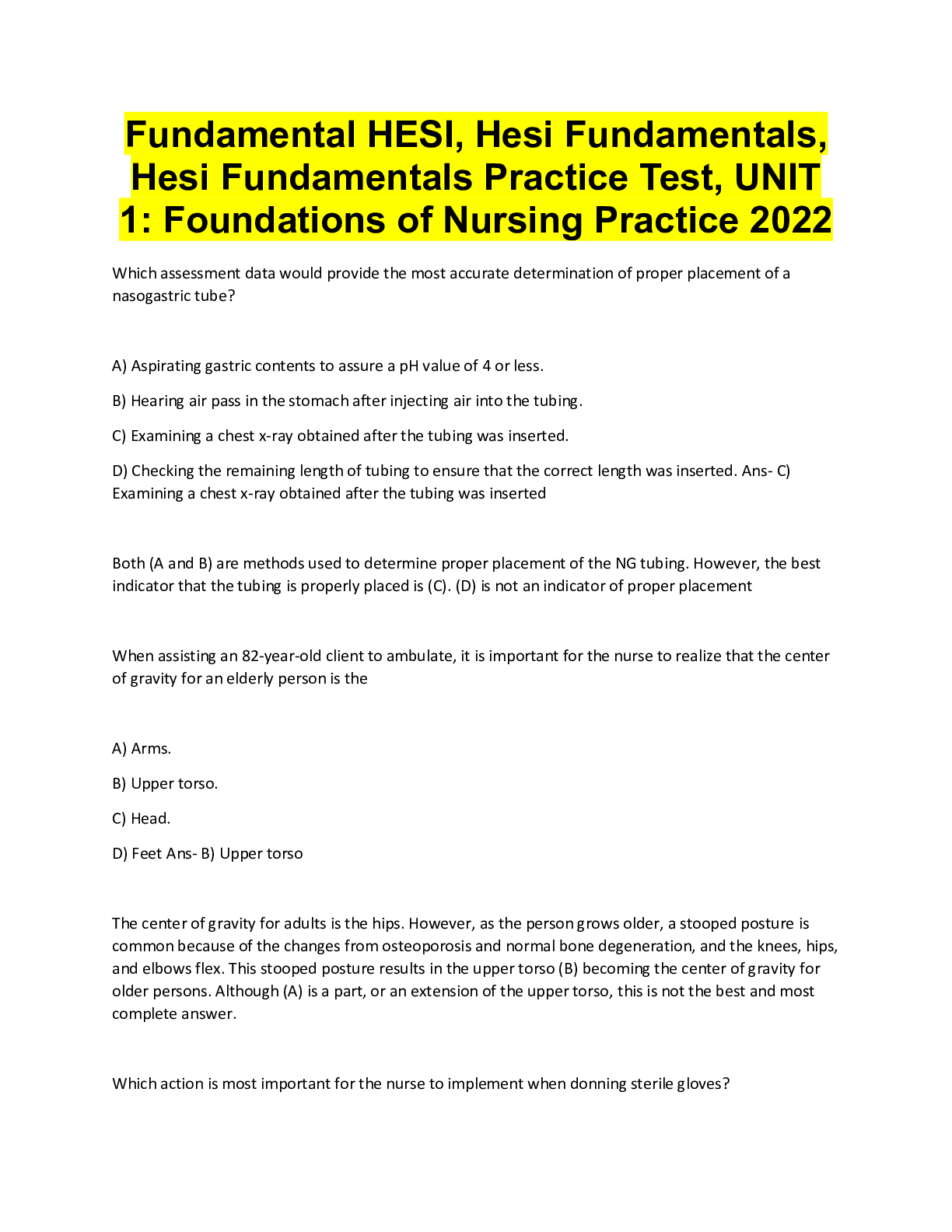
Buy this document to get the full access instantly
Instant Download Access after purchase
Add to cartInstant download
We Accept:

Reviews( 0 )
$10.00
Document information
Connected school, study & course
About the document
Uploaded On
Aug 24, 2022
Number of pages
98
Written in
Additional information
This document has been written for:
Uploaded
Aug 24, 2022
Downloads
0
Views
38

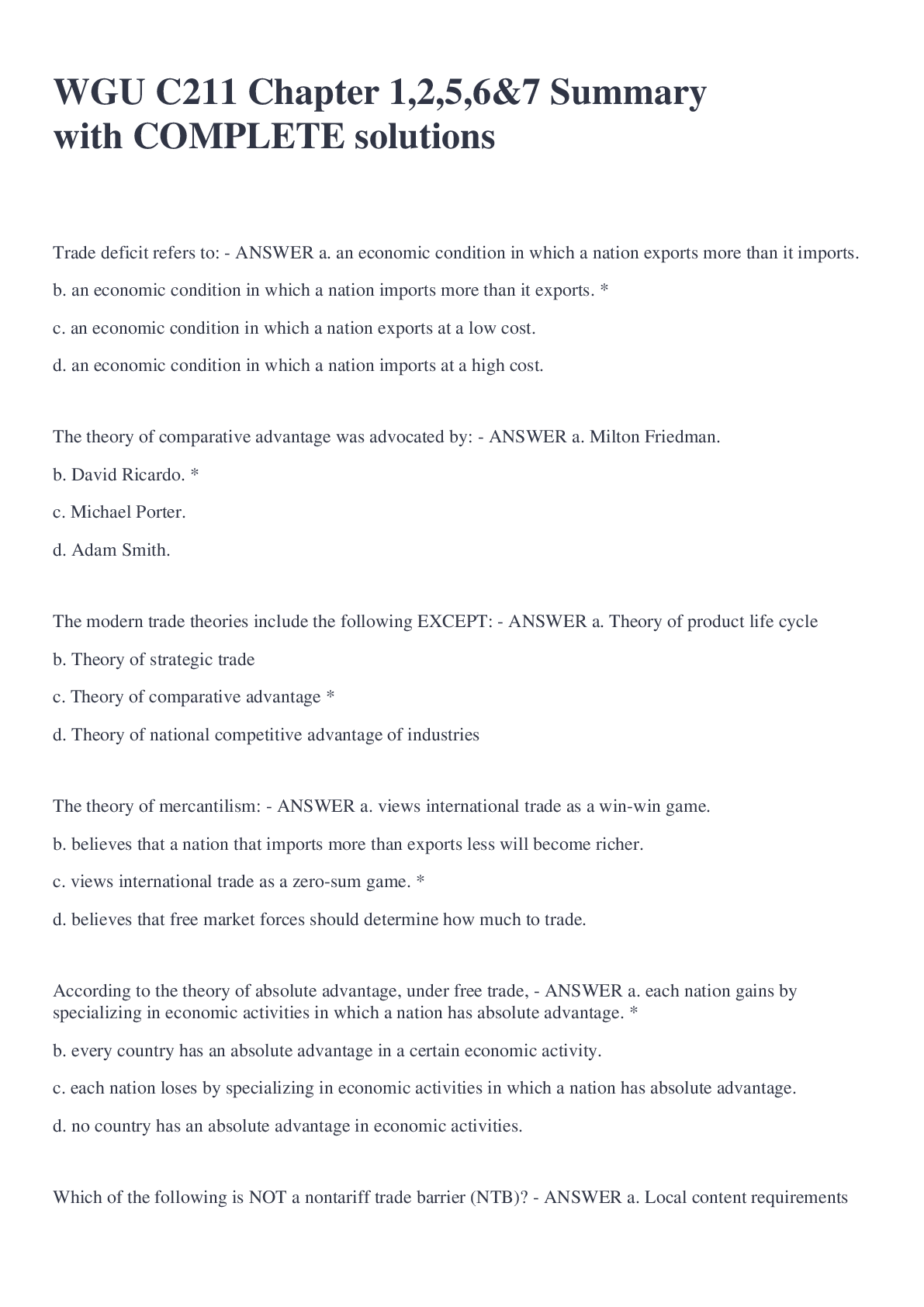
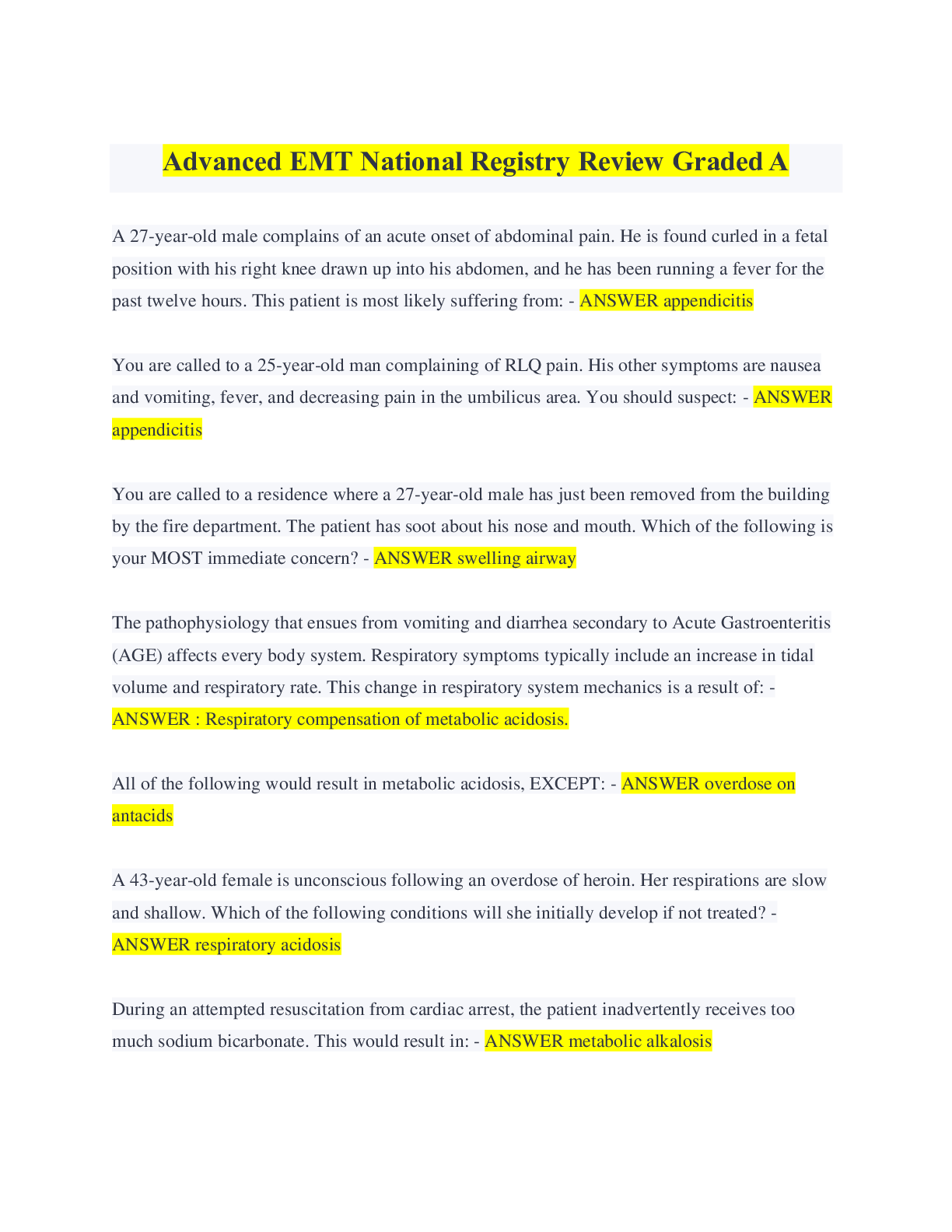
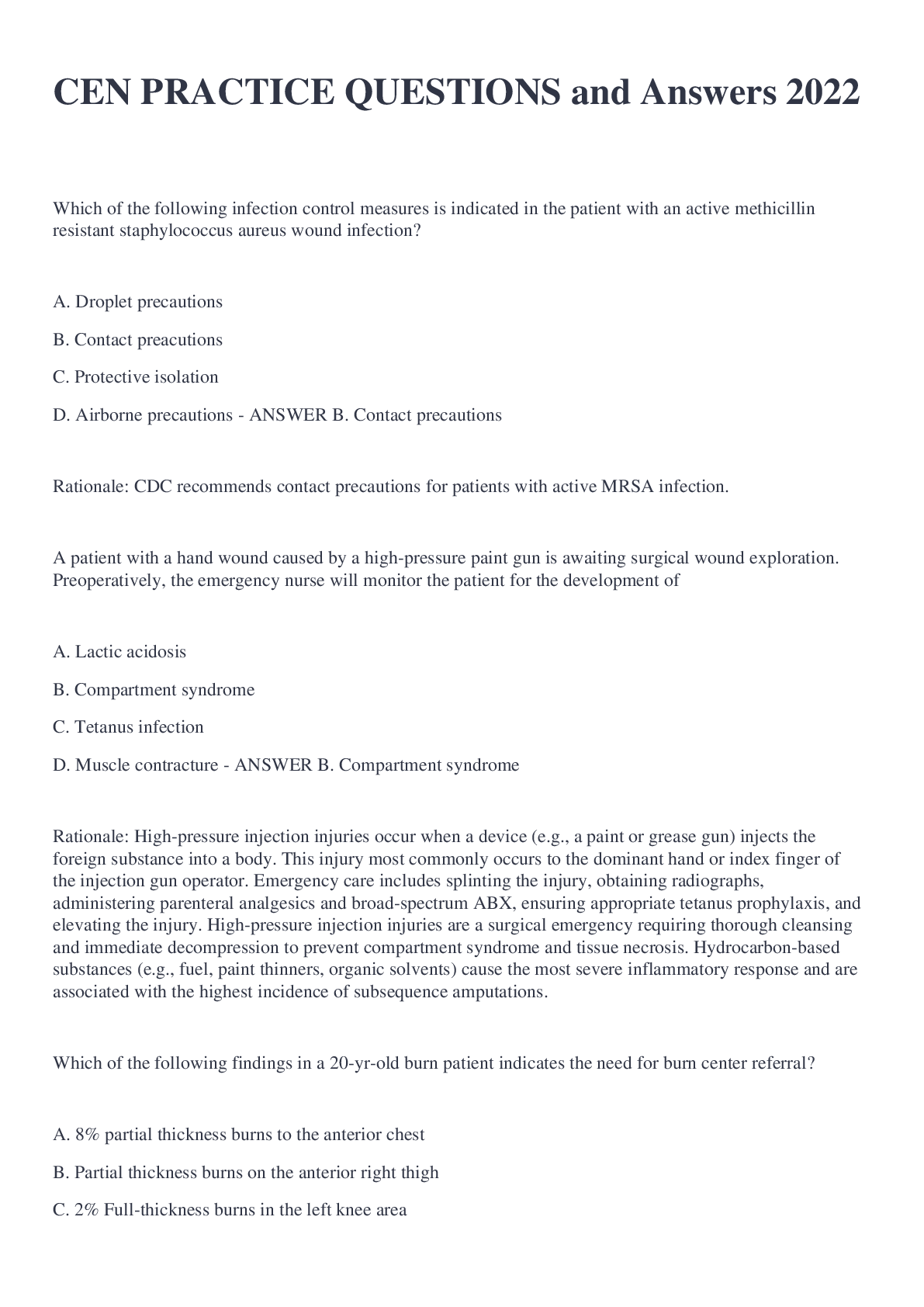


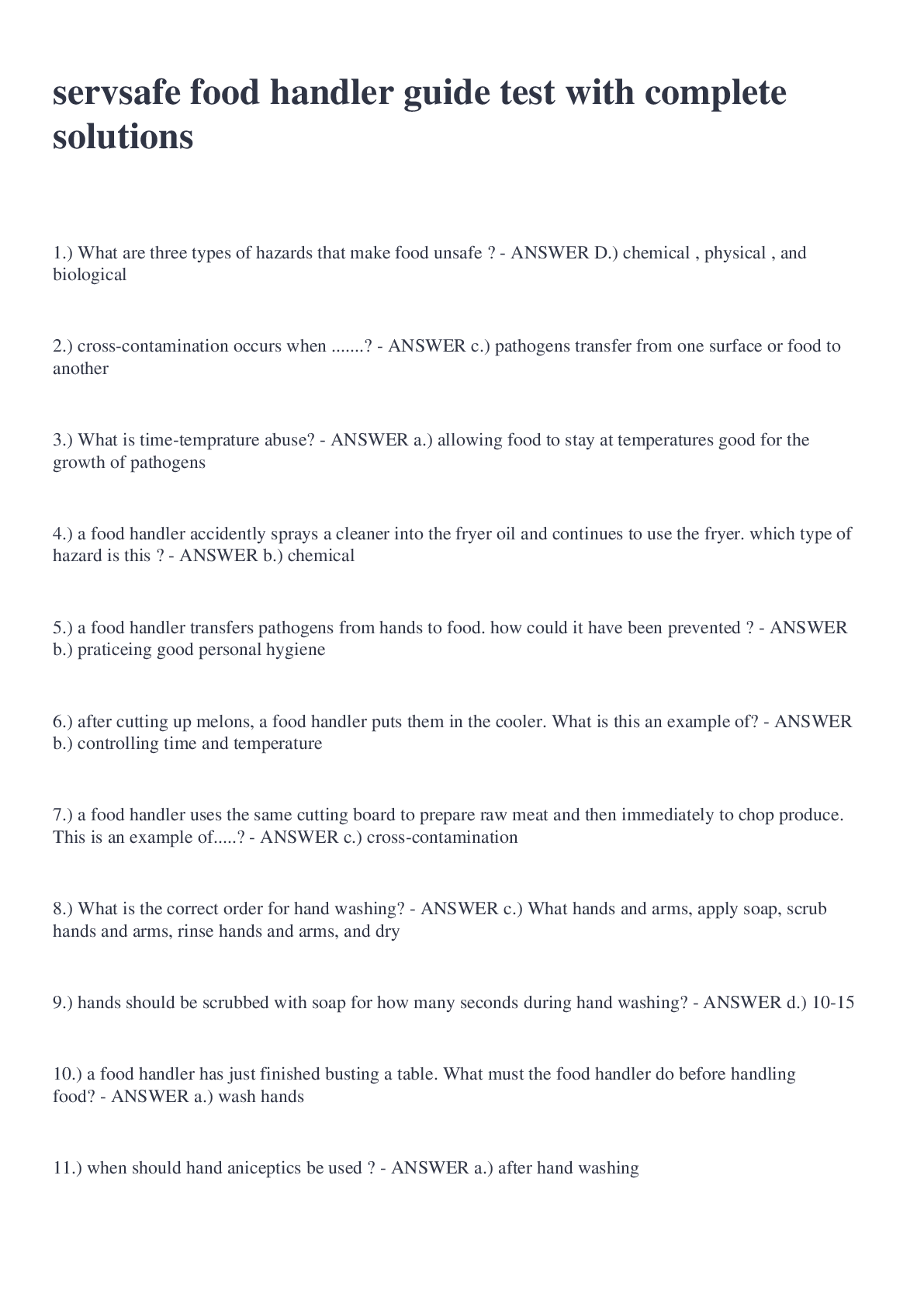


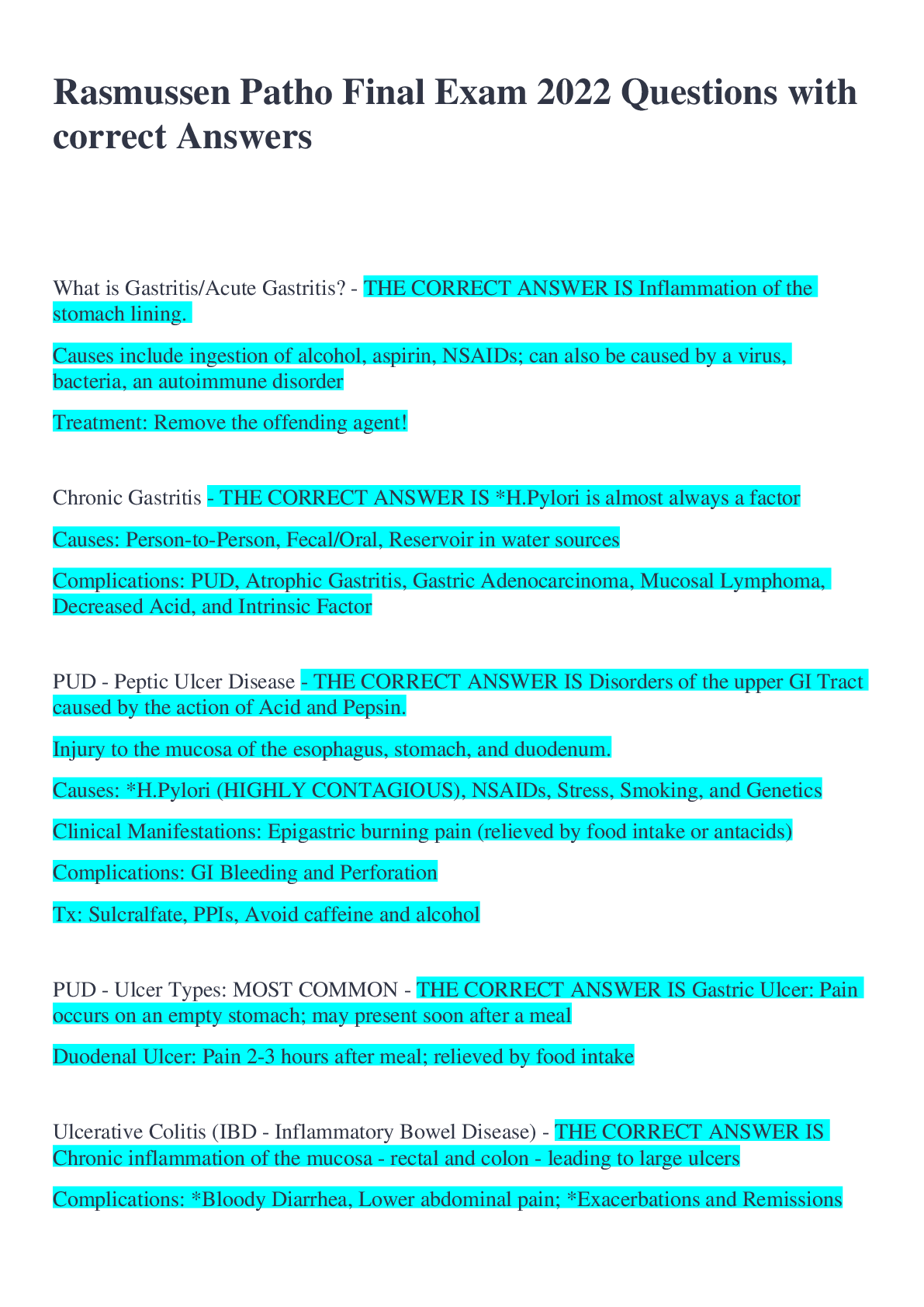
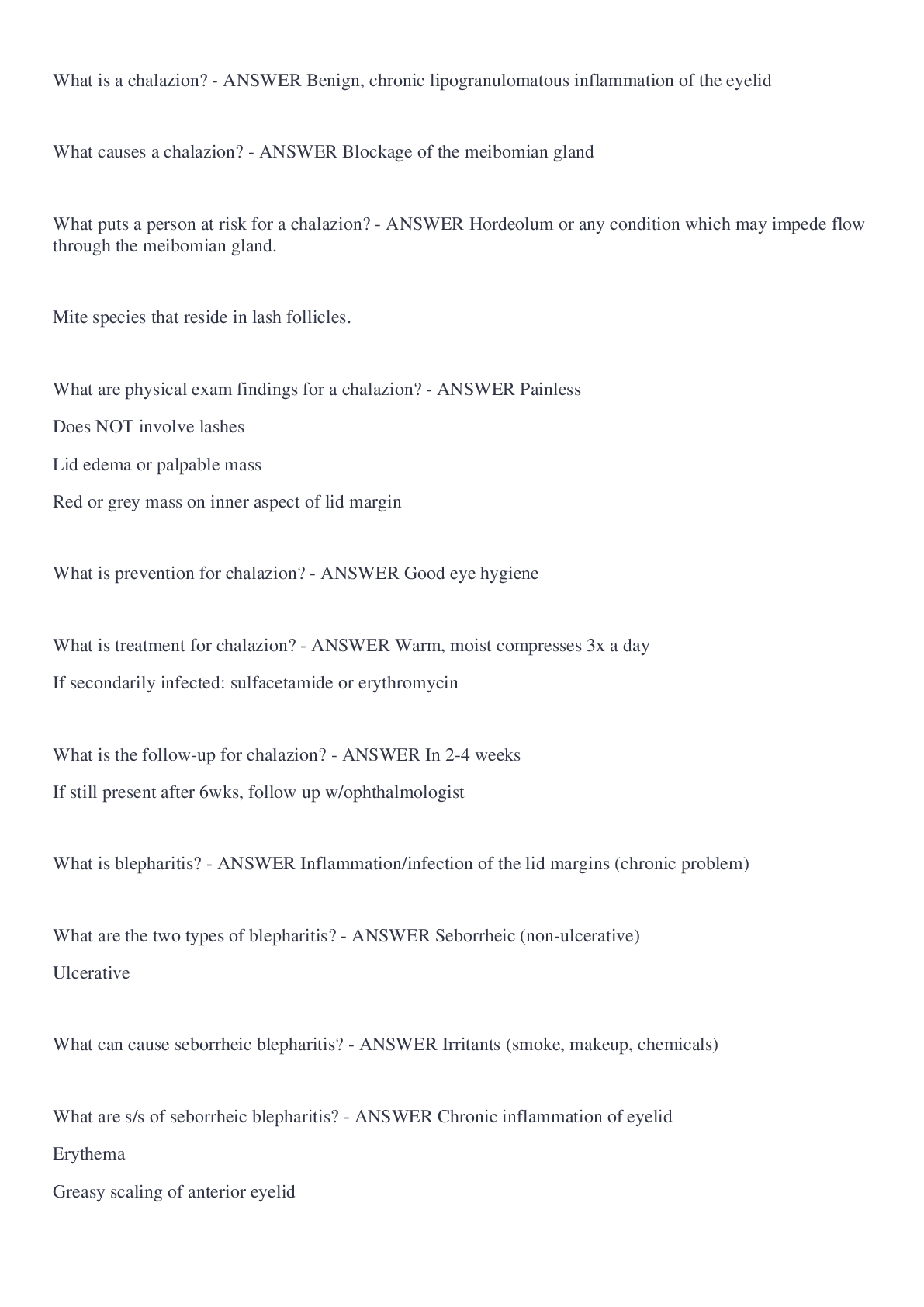
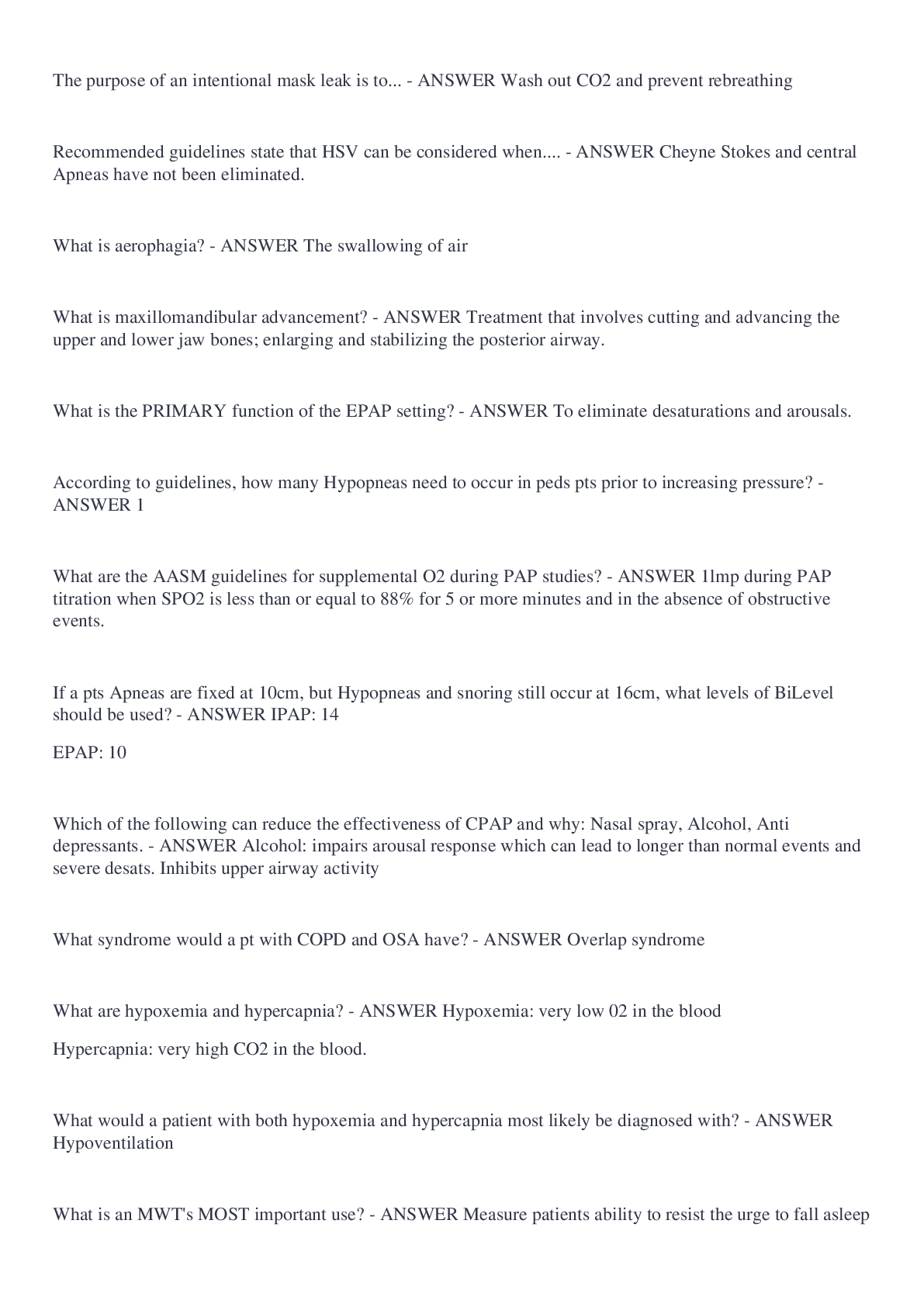

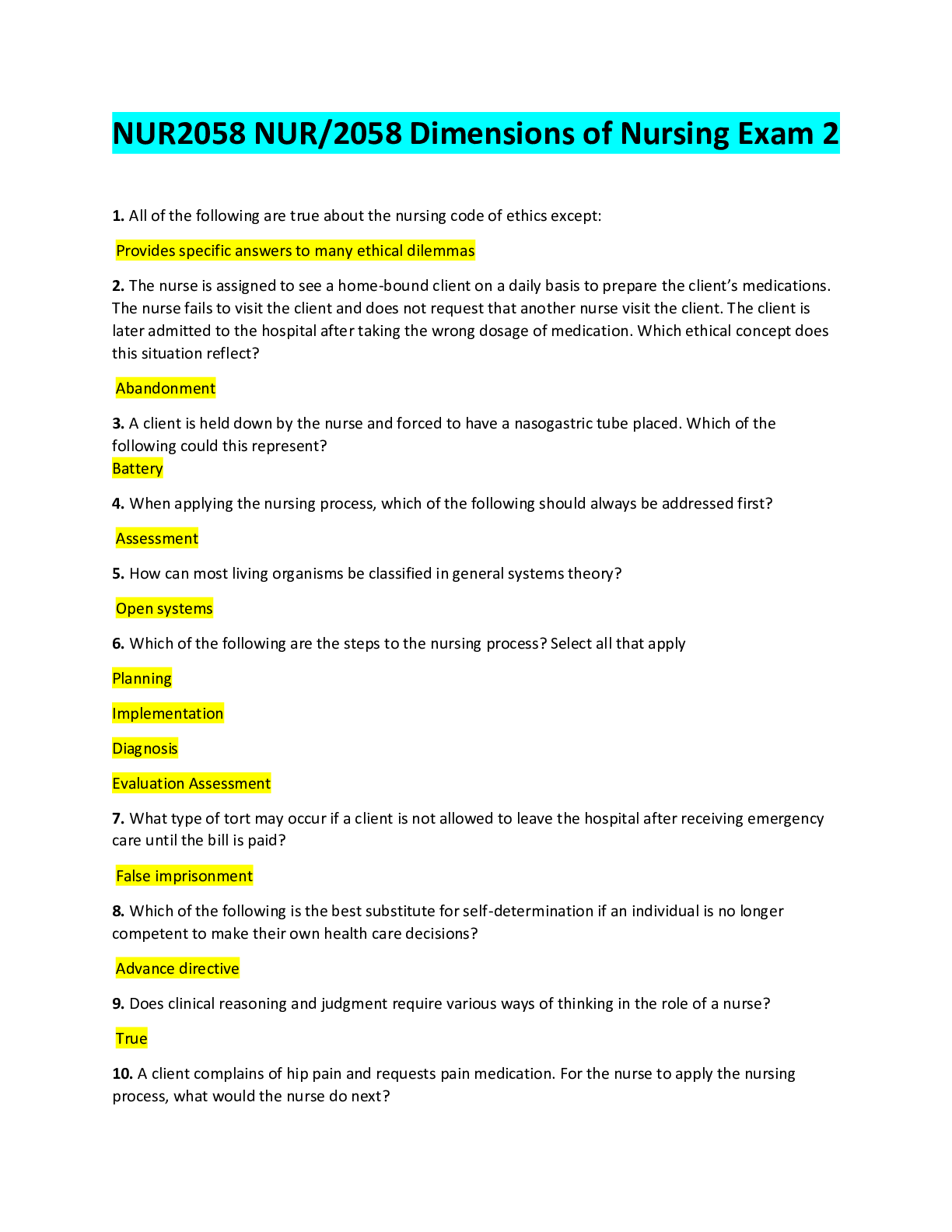
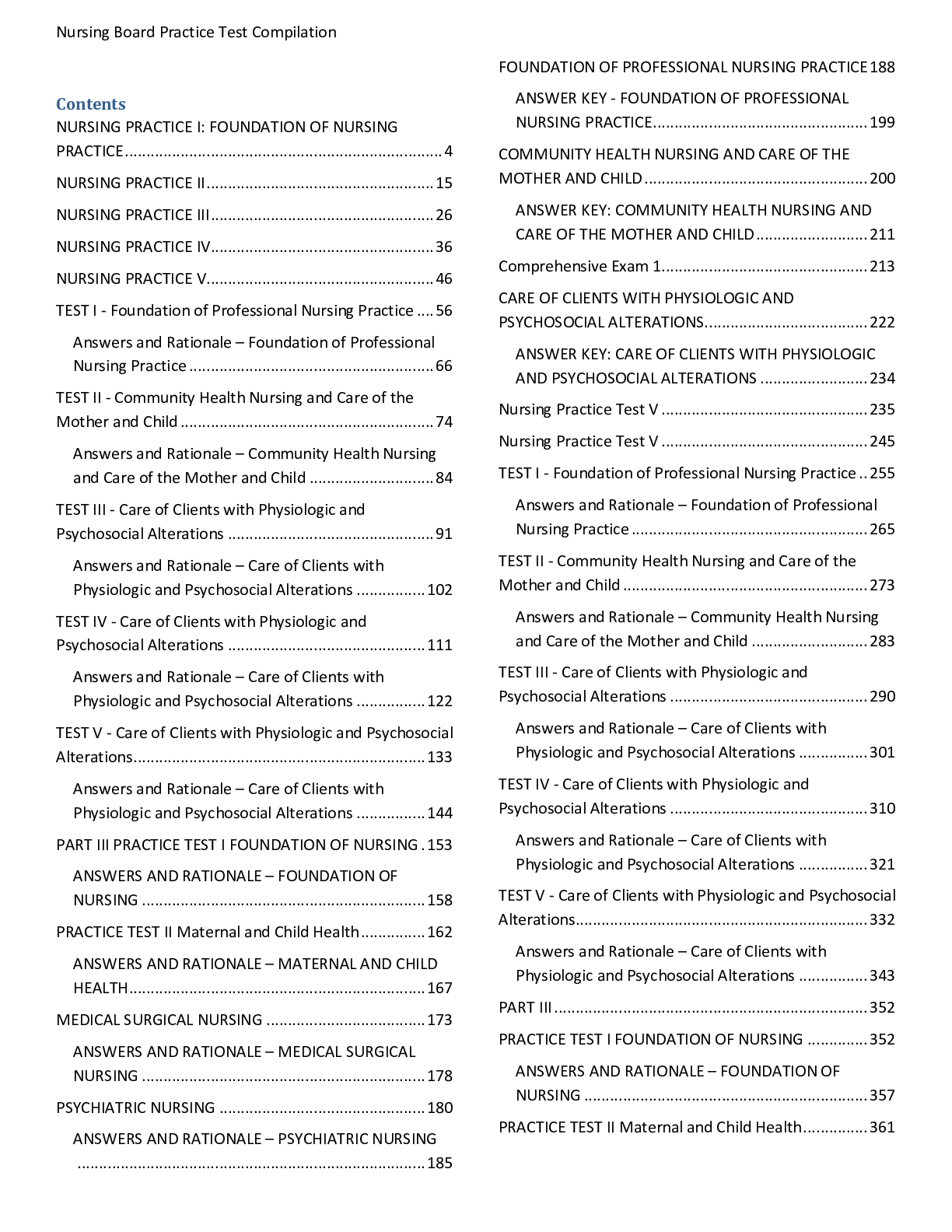
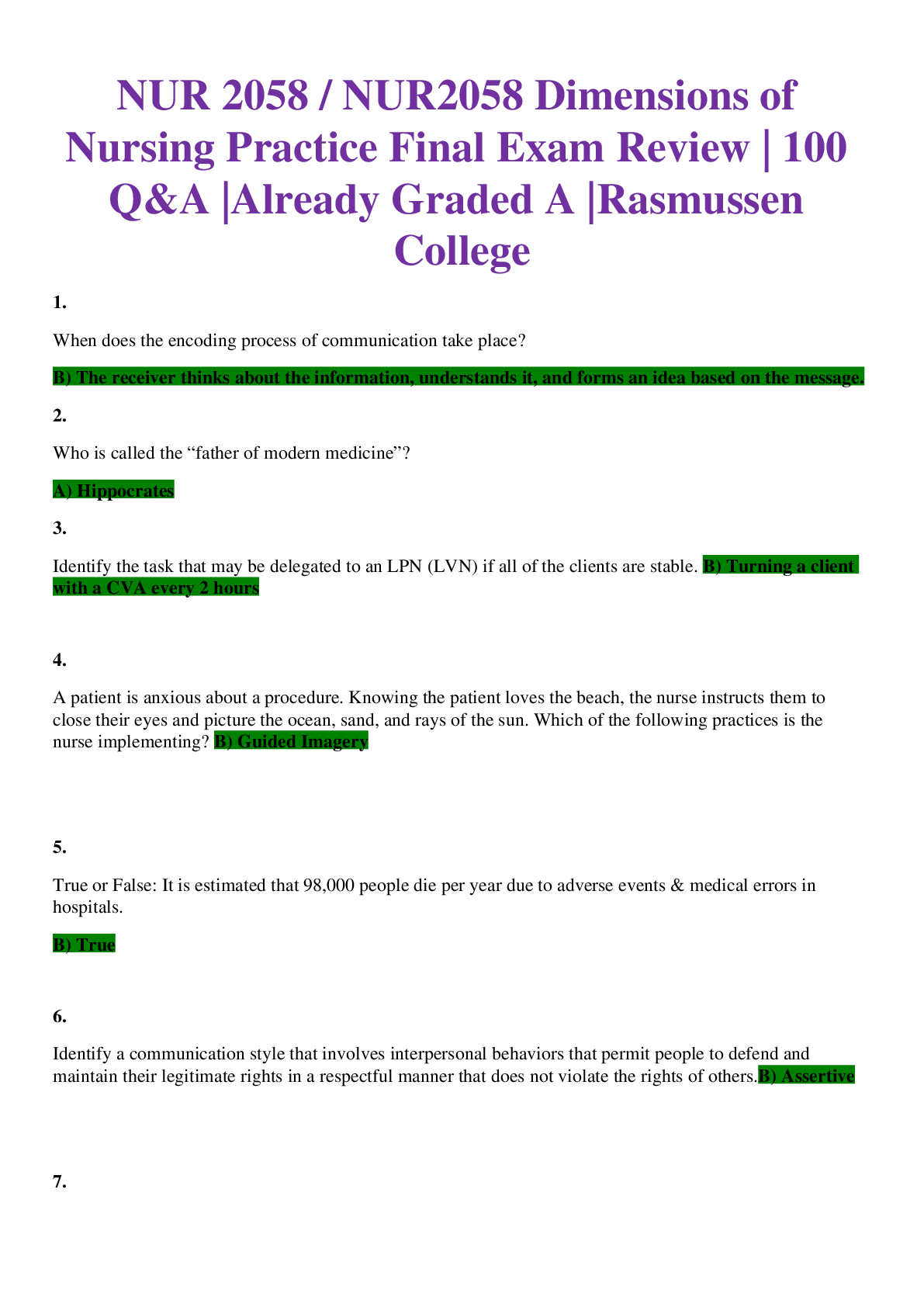
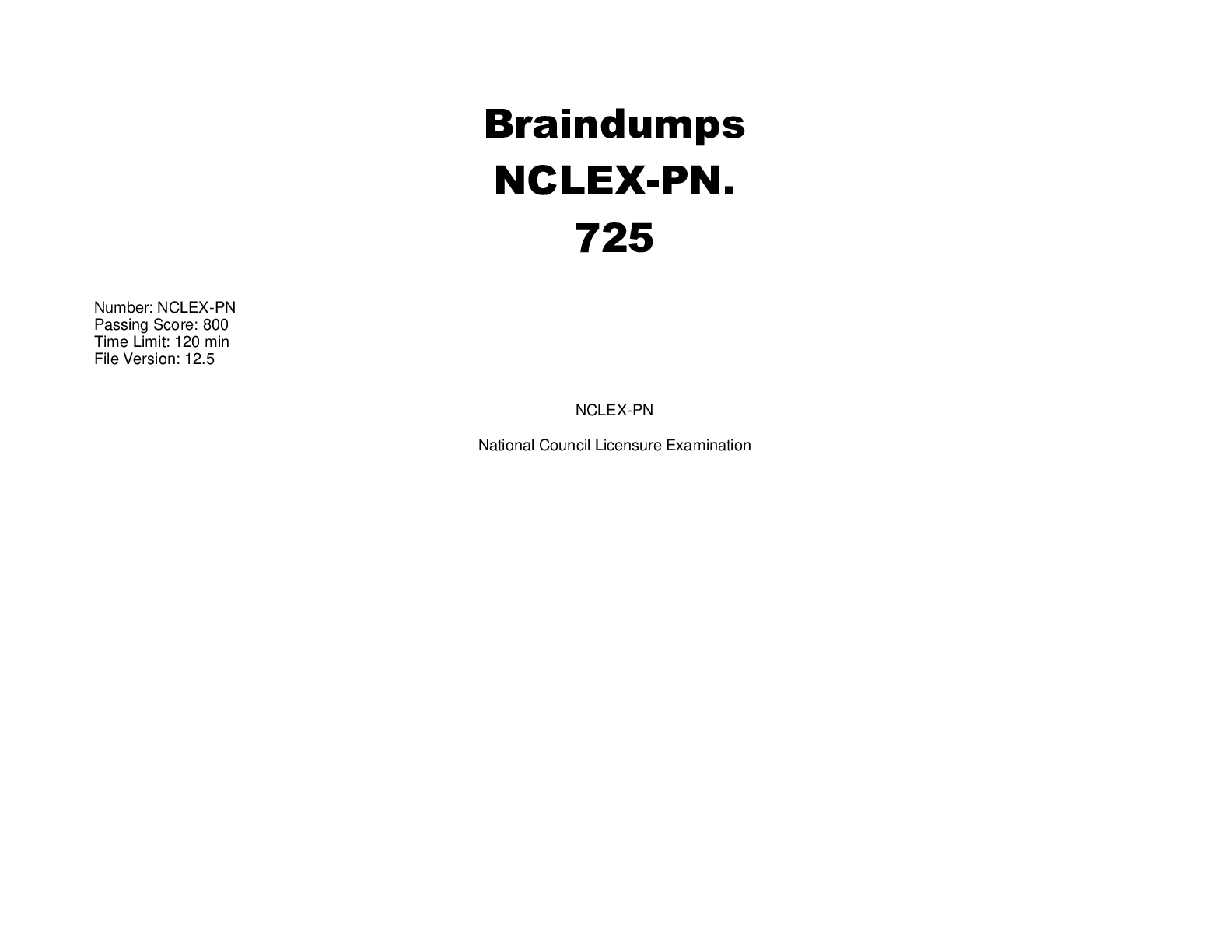
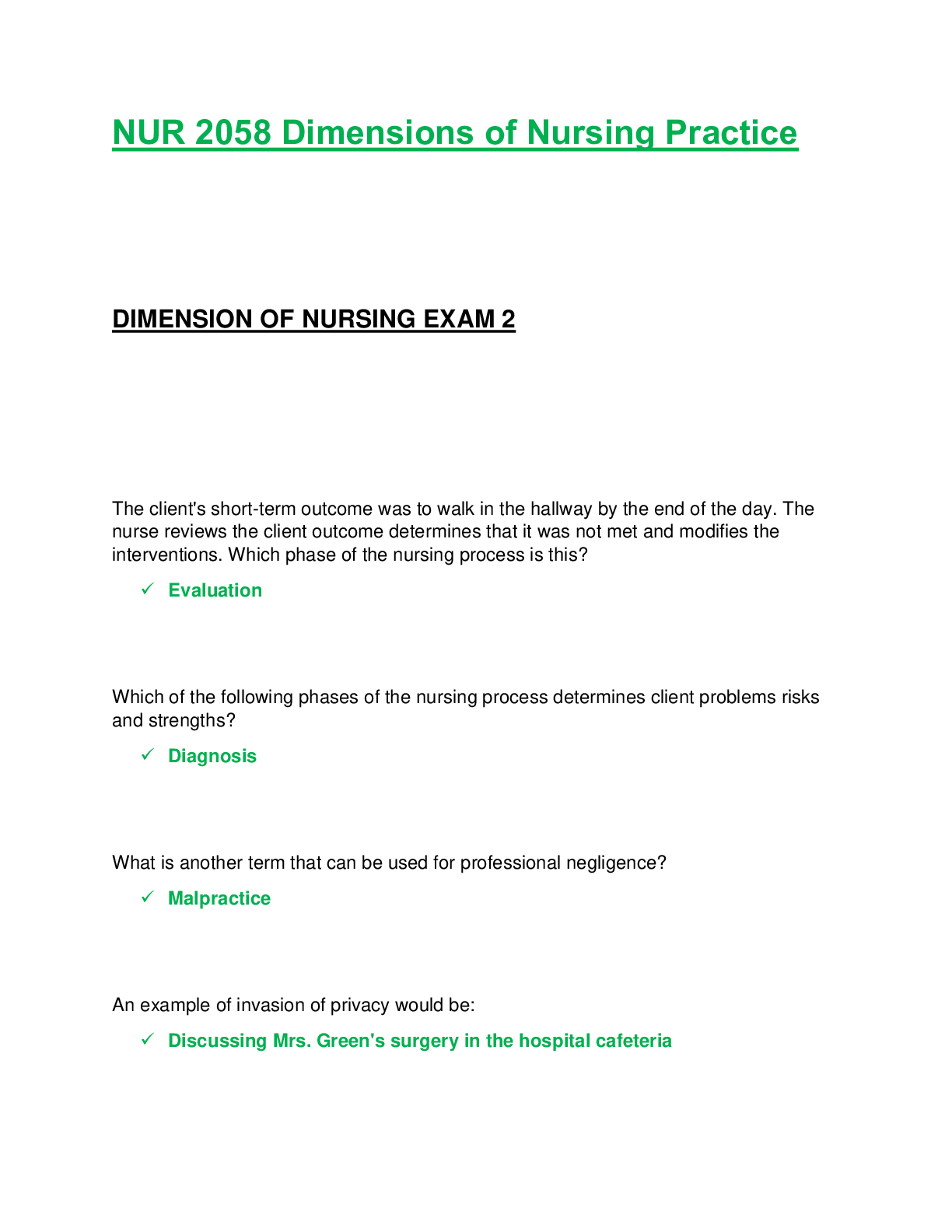
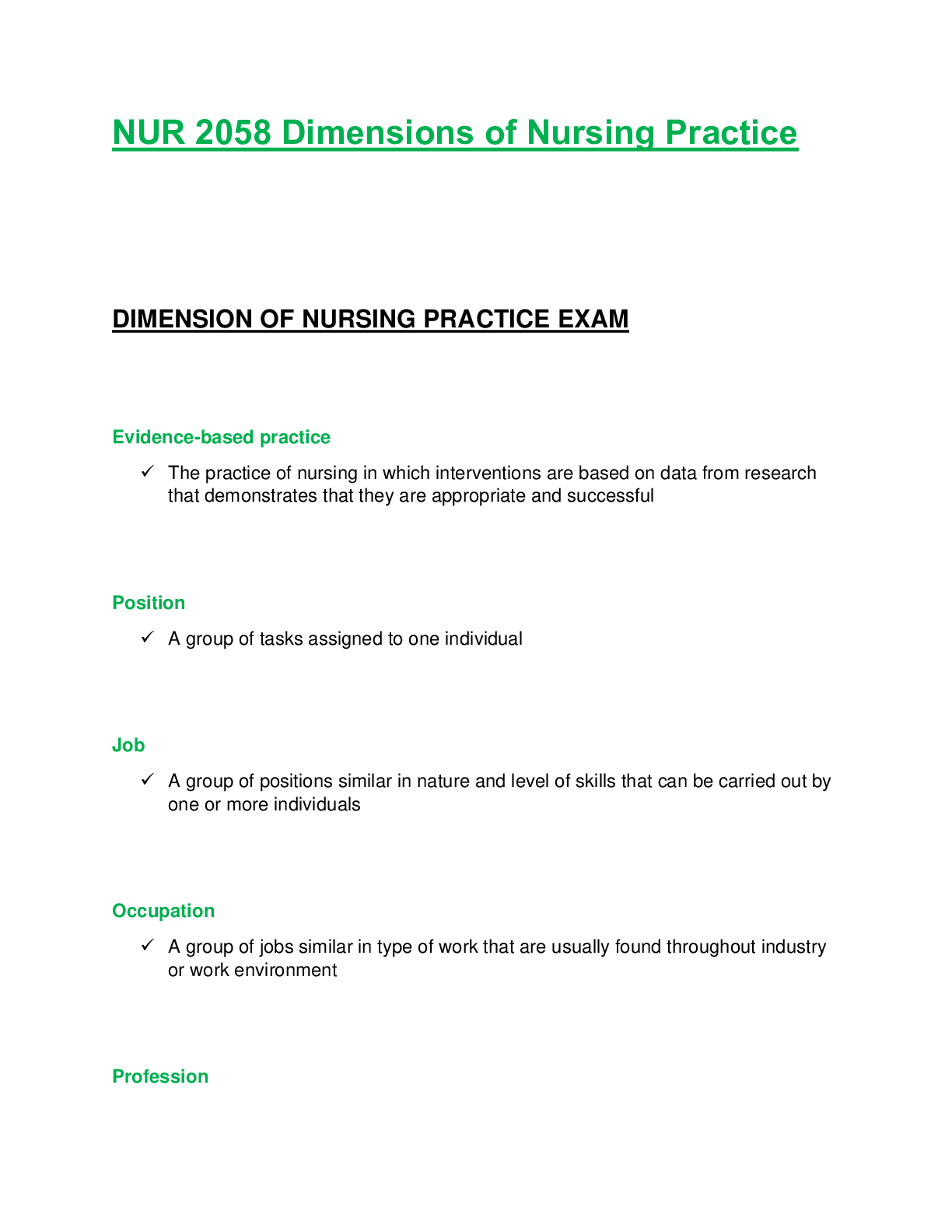
.png)
